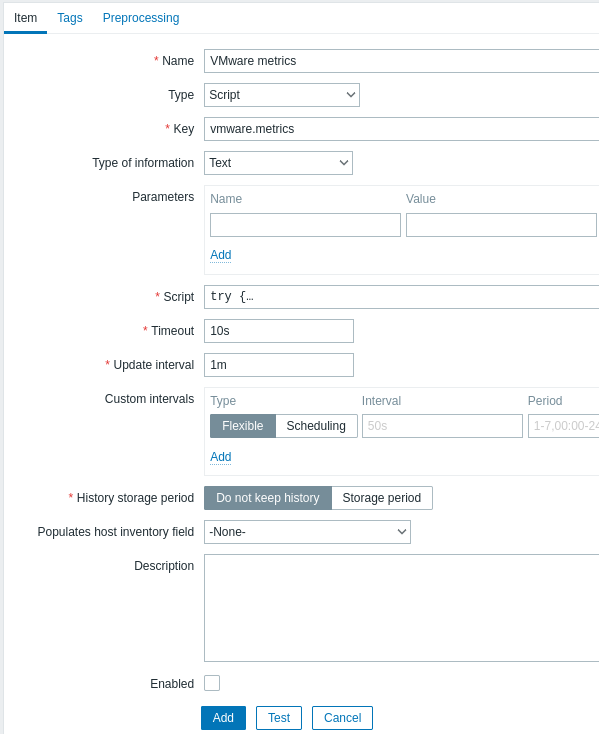16 Egyéni teljesítményszámláló nevek létrehozása a VMware számára
Áttekintés
A VMware teljesítményszámláló elérési útja a csoport/számláló[összegzés] formátum, ahol:
- "csoport" - a teljesítményszámláló csoport, például cpu
- "számláló" - a teljesítményszámláló neve, például usamhz
- "összegzés" - például a teljesítményszámláló összesítő típusa átlagos
Tehát a fenti példa a következő számláló utat adná meg: cpu/usagemhz[átlag]
A teljesítményszámláló csoportok leírása, számlálónevek és összesítés típusai a [VMware dokumentáció] (https://developer.vmware.com/apis/968).
Lehetőség van belső nevek beszerzésére és egyéni teljesítményszámláló-nevek létrehozására a Zabbix szkriptelemének használatával.
Configuration
- Create disabled Script item on the main VMware host (where the eventlog[] item is present) with the following parameters:

- Name: VMware metrics
- Type: Script
- Key: vmware.metrics
- Type of information: Text
- Script: copy and paste the script provided below
- Timeout: 10
- History storage period: Do not keep history
- Enabled: unmarked
Script
try {
Zabbix.log(4, 'vmware metrics script');
var result, resp,
req = new HttpRequest();
req.addHeader('Content-Type: application/xml');
req.addHeader('SOAPAction: "urn:vim25/6.0"');
login = '<soapenv:Envelope xmlns:soapenv="http://schemas.xmlsoap.org/soap/envelope/" xmlns:urn="urn:vim25">\
<soapenv:Header/>\
<soapenv:Body>\
<urn:Login>\
<urn:_this type="SessionManager">SessionManager</urn:_this>\
<urn:userName>{$VMWARE.USERNAME}</urn:userName>\
<urn:password>{$VMWARE.PASSWORD}</urn:password>\
</urn:Login>\
</soapenv:Body>\
</soapenv:Envelope>'
resp = req.post("{$VMWARE.URL}", login);
if (req.getStatus() != 200) {
throw 'Response code: '+req.getStatus();
}
query = '<soapenv:Envelope xmlns:soapenv="http://schemas.xmlsoap.org/soap/envelope/" xmlns:urn="urn:vim25">\
<soapenv:Header/>\
<soapenv:Body>\
<urn:RetrieveProperties>\
<urn:_this type="PropertyCollector">propertyCollector</urn:_this>\
<urn:specSet>\
<urn:propSet>\
<urn:type>PerformanceManager</urn:type>\
<urn:pathSet>perfCounter</urn:pathSet>\
</urn:propSet>\
<urn:objectSet>\
<urn:obj type="PerformanceManager">PerfMgr</urn:obj>\
</urn:objectSet>\
</urn:specSet>\
</urn:RetrieveProperties>\
</soapenv:Body>\
</soapenv:Envelope>'
resp = req.post("{$VMWARE.URL}", query);
if (req.getStatus() != 200) {
throw 'Response code: '+req.getStatus();
}
Zabbix.log(4, 'vmware metrics=' + resp);
result = resp;
logout = '<soapenv:Envelope xmlns:soapenv="http://schemas.xmlsoap.org/soap/envelope/" xmlns:urn="urn:vim25">\
<soapenv:Header/>\
<soapenv:Body>\
<urn:Logout>\
<urn:_this type="SessionManager">SessionManager</urn:_this>\
</urn:Logout>\
</soapenv:Body>\
</soapenv:Envelope>'
resp = req.post("{$VMWARE.URL}",logout);
if (req.getStatus() != 200) {
throw 'Response code: '+req.getStatus();
}
} catch (error) {
Zabbix.log(4, 'vmware call failed : '+error);
result = {};
}
return result;Once the item is configured, press Test button, then press Get value.

Copy received XML to any XML formatter and find the desired metric.
An example of XML for one metric:
<PerfCounterInfo xsi:type="PerfCounterInfo">
<key>6</key>
<nameInfo>
<label>Usage in MHz</label>
<summary>CPU usage in megahertz during the interval</summary>
<key>usagemhz</key>
</nameInfo>
<groupInfo>
<label>CPU</label>
<summary>CPU</summary>
<key>cpu</key>
</groupInfo>
<unitInfo>
<label>MHz</label>
<summary>Megahertz</summary>
<key>megaHertz</key>
</unitInfo>
<rollupType>average</rollupType>
<statsType>rate</statsType>
<level>1</level>
<perDeviceLevel>3</perDeviceLevel>
</PerfCounterInfo>Use XPath to extract the counter path from received XML. For the example above, the XPath will be:
| field | xPath | value |
|---|---|---|
| group | //groupInfo[../key=6]/key | cpu |
| counter | //nameInfo[../key=6]/key | usagemhz |
| rollup | //rollupType[../key=6] | average |
Resulting performance counter path in this case is: cpu/usagemhz[average]
